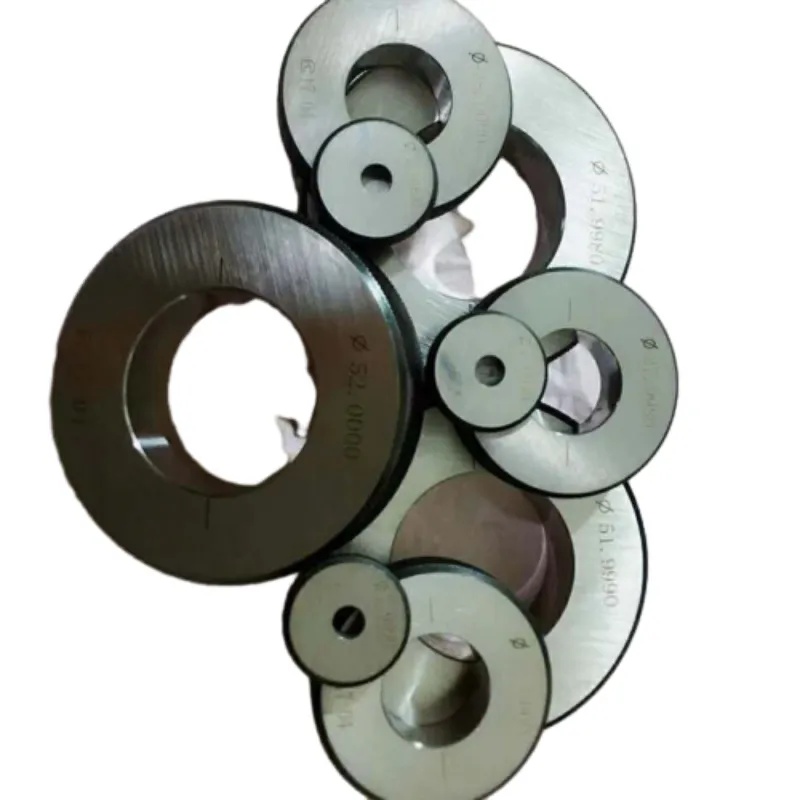Dec . 30, 2024 11:43 Khutlela lethathamong
Ring Gauge Measurement
In precision engineering and manufacturing, accurate measurement is crucial. One of the most essential tools used for ensuring the correct sizing of parts is the ring gauge. Ring gauges are highly effective in measuring the external diameter of a component or a workpiece, ensuring that the dimensions meet the required tolerances. This article delves into the fundamental aspects of ring gauge measurement, its types, applications, and its importance in quality control processes.
What is a Ring Gauge?
A ring gauge is a cylindrical tool used to measure the external dimensions of a part, specifically the diameter, by determining whether the workpiece fits within or outside the gauge's interior or exterior surfaces. It is primarily used in manufacturing industries for checking the size and tolerance of components like shafts, bolts, and other cylindrical parts.
Internal Ring Gauges: These have an internal diameter and are used to measure the external dimensions of a part.
External Ring Gauges: These have an outer diameter and are used to check the internal dimensions of a hole or bore.
The gauge itself is made with high precision to ensure the accurate measurement of the part in question.
Types of Ring Gauges and Their Applications
Ring gauges come in several different types, each serving a specific purpose based on the measurements they are designed to handle.
Fixed Limit Ring Gauges
These gauges have a single, fixed tolerance limit and are used to determine whether a part is within the specified limits for its size.
Application: Commonly used in quality control and inspection, ensuring that components meet the required specifications.
Adjustable Ring Gauges
These offer flexibility by allowing adjustments in the gauge's size to accommodate different tolerances.
Application: Used in situations where frequent changes in size are necessary or when testing parts with varying dimensions.
Go/No-Go Ring Gauges
These gauges are designed to test if a part fits within the "go" and "no-go" limits.
Application: Essential in production lines for quick, pass/fail checks without the need for precise measurements.
Master Ring Gauges
These are used as reference standards to calibrate other gauges or measuring instruments.
Application: Crucial in ensuring that other gauges are providing accurate measurements during manufacturing.
How is Ring Gauge Measurement Performed?
The process of ring gauge measurement involves placing a component into the gauge and checking for its fit. The gauge either passes or fails based on whether the component is within the specified dimensions.
For External Ring Gauges: The component is inserted into the ring gauge, and if it fits perfectly, the component meets the required size.
For Internal Ring Gauges: The component is placed inside the ring gauge to check whether its outer diameter is within the tolerance limits.
The accuracy of ring gauge measurements is critical, as even a small deviation can result in improper fitment or functionality of the component. Therefore, regular calibration of the ring gauge is essential to maintain its precision.
Importance of Ring Gauge Measurement in Quality Control
Ring gauges play a pivotal role in quality control processes across various industries, including automotive, aerospace, and electronics. The precise measurement of parts ensures:
Consistency: Ring gauges help maintain consistency in manufacturing, ensuring that all parts meet the required specifications.
Reduced Error: By using ring gauges, manufacturers can avoid errors associated with manual measurements, improving overall efficiency.
Increased Productivity: With quick and reliable measurements, production lines can operate smoothly without delays due to faulty parts.
Compliance with Standards: Accurate measurements help in adhering to international and industry-specific standards, which is crucial for maintaining certifications and meeting customer expectations.
Challenges in Ring Gauge Measurement
While ring gauges are effective tools, they do come with certain challenges that need to be addressed:
Wear and Tear: Over time, ring gauges can wear out, causing them to lose their precision. Regular calibration and maintenance are required to ensure they maintain their accuracy.
Temperature Sensitivity: Measurements can be affected by temperature fluctuations. It is important to perform measurements under controlled conditions.
Measurement Tolerance: The accuracy of the measurement depends on the tolerance of the ring gauge. A high tolerance gauge is required for precise measurements in critical applications.
In summary, ring gauge measurement is a crucial aspect of precision manufacturing, ensuring that parts fit within specified dimensions and tolerances. The proper use of ring gauges, whether they are internal or external, adjustable or fixed, is vital for maintaining quality control standards. As industries continue to demand higher levels of accuracy, the role of ring gauges in ensuring the reliability and precision of parts will only grow more important. Regular calibration, proper maintenance, and attention to environmental factors are essential to ensure accurate and consistent results.
For manufacturers looking to enhance their quality control processes, investing in high-quality ring gauges and understanding their proper usage can lead to improved product consistency, reduced waste, and increased customer satisfaction.

-
Why Metric Trapezoidal Thread is Ideal for Precision Motion ControlLitabaAug.05,2025
-
The Unique Properties of a Block of Granite for Industrial UseLitabaAug.05,2025
-
The Role of Flanged Y Strainers in Preventing Pipeline ClogsLitabaAug.05,2025
-
The Importance of Regular Calibration for Master Ring GagesLitabaAug.05,2025
-
How a Cast Iron Surface Table Enhances Accuracy in ManufacturingLitabaAug.05,2025
-
Comparing Different Check Valve Types for Optimal Flow ControlLitabaAug.05,2025
Tse amanang le PRODUCTS
Sep . 18, 2024 02:53 Khutlela lethathamong
ring gauge measurement
Understanding Ring Gauge Measurement A Comprehensive Overview
Ring gauge measurement is a critical process used in manufacturing and quality control to ensure that parts and components meet specified tolerances and dimensional requirements. This technique is especially prevalent in industries such as aerospace, automotive, and precision engineering, where even the smallest deviation can lead to significant performance issues or safety concerns.
At its core, a ring gauge is a cylindrical tool with a precisely machined inner diameter. It is typically used to measure the external diameter of shafts, pins, and other cylindrical parts. The design of the ring gauge allows it to slide over the part being measured, providing a straightforward means to check for dimensional accuracy. Ring gauges come in two main types go gauges and no-go gauges. The go gauge is intended to fit over the part, indicating that the part is within the acceptable tolerance. Conversely, the no-go gauge should not fit; if it does, it highlights that the part exceeds the maximum allowable size.
One of the primary advantages of using ring gauges is their simplicity and effectiveness. Unlike other measurement tools that may require more complex setups or interpretations, ring gauges provide a binary result—either a pass or fail. This straightforward methodology makes them ideal for high-volume production environments where rapid inspections are necessary. Additionally, ring gauges can be made from various materials, including hardened steel or carbide, ensuring durability and resistance to wear over time.
ring gauge measurement

Accurate ring gauge measurement requires adherence to specific calibration and handling procedures. Before use, it is crucial to ensure that the gauge is clean, free from debris, and not damaged. Any contaminants or imperfections on the gauge or the part can lead to inaccurate measurements. Moreover, ambient conditions such as temperature and humidity can also affect the measurement accuracy. Therefore, it's recommended to conduct measurements in a controlled environment to minimize these variables.
In the context of quality assurance, ring gauge measurement plays a pivotal role in the production cycle. Implementing rigorous measurement practices using ring gauges helps manufacturers maintain high standards of quality. Regularly scheduled calibrations and audits of the gauges themselves are essential to uphold their accuracy over time. This ongoing commitment to quality not only enhances product reliability but also strengthens consumer trust in the manufacturer.
In conclusion, ring gauge measurement is an invaluable tool in the quality control arsenal of modern manufacturing. Its ability to deliver quick and reliable results makes it indispensable in settings where precision is paramount. By understanding and properly utilizing ring gauges, manufacturers can significantly enhance their quality assurance processes, leading to improved product outcomes and heightened customer satisfaction. As industries continue to evolve, the importance of effective measurement techniques like ring gauges will remain a cornerstone of production excellence.
-
Why Metric Trapezoidal Thread is Ideal for Precision Motion ControlLitabaAug.05,2025
-
The Unique Properties of a Block of Granite for Industrial UseLitabaAug.05,2025
-
The Role of Flanged Y Strainers in Preventing Pipeline ClogsLitabaAug.05,2025
-
The Importance of Regular Calibration for Master Ring GagesLitabaAug.05,2025
-
How a Cast Iron Surface Table Enhances Accuracy in ManufacturingLitabaAug.05,2025
-
Comparing Different Check Valve Types for Optimal Flow ControlLitabaAug.05,2025
Tse amanang le PRODUCTS









